1997 CHEVROLET CAVALIER parking brake
[x] Cancel search: parking brakePage 229 of 388

Downloaded from www.Manualslib.com manuals search engine Changing a Flat Tire
If a tire goes flat, avoid further tire and wheel damage
by driving slowly to a level place. Turn on your hazard
warning flashers.
Changing
a tire can cause an injury. The vehicle
can slip
off the jack and roll over you or other
people.
You and they could be badly injured.
Find
a level place to change your tire. To help
prevent the vehicle from moving:
1. Set the parking brake firmly.
2. Put an automatic transaxle shift lever in
PARK (P), or shift a manual transaxle to
FIRST
(1) or REVERSE (R).
3. Turn off the engine.
To be even more certain the vehicle won’t move,
you can put blocks at the front and rear of the
tire farthest
away from the one being changed.
That would be the
tire on the other side of the
vehicle,
at the opposite end.
........................................................................\
........ ........................................................................\
......... ........................................................................\
........ ........................................... .......................................... .................. ........................................... ..........................................
The following steps will tell you how to use the jack and
change a tire.
5-23
. - -. ....... - ........ - - . .~
Page 261 of 388

Downloaded from www.Manualslib.com manuals search engine Because this operation can be a little difficult, you may
choose to have this done
at your Chevrolet dealership
Service Department.
If you do it yourself, be sure to follow all the instructions
here, or you could get
a false reading on the dipstick.
NOTICE:
Too much or too little fluid can damage your
transaxle.
Too much can mean that some of the
fluid could come out and fall on hot engine parts
or exhaust system parts, starting a fire. Be sure to
get an accurate reading if
you check your
transaxle fluid.
Wait at least 30 minutes before checking the transaxle
fluid level if you have been driving:
0 When outside temperatures are above 90°F (32°C).
At high speed for quite a while.
In heavy traffic -- especially in hot weather.
0 While pulling a trailer.
To get the right reading, the fluid should be at normal
operating temperature, which is
180°F to 200" F
(82°C to 93°C).
Get the vehicle warmed up by driving about
15 miles
(24 km) when outside temperatures are above 50°F
(10°C). If it's colder than 50°F (lO"C), you may have
to drive longer.
Checking the Fluid Level
0
0
0
0
Park your vehicle on a level place. Keep the
engine running.
With the parking brake applied, place the shift lever
in
PARK (P).
With your foot on the brake pedal, move the shift
lever through each gear range, pausing for about
three seconds in each range. Then, position the shift
lever in
PARK (P).
Let the engine run at idle for three to five mhutes.
Page 351 of 388
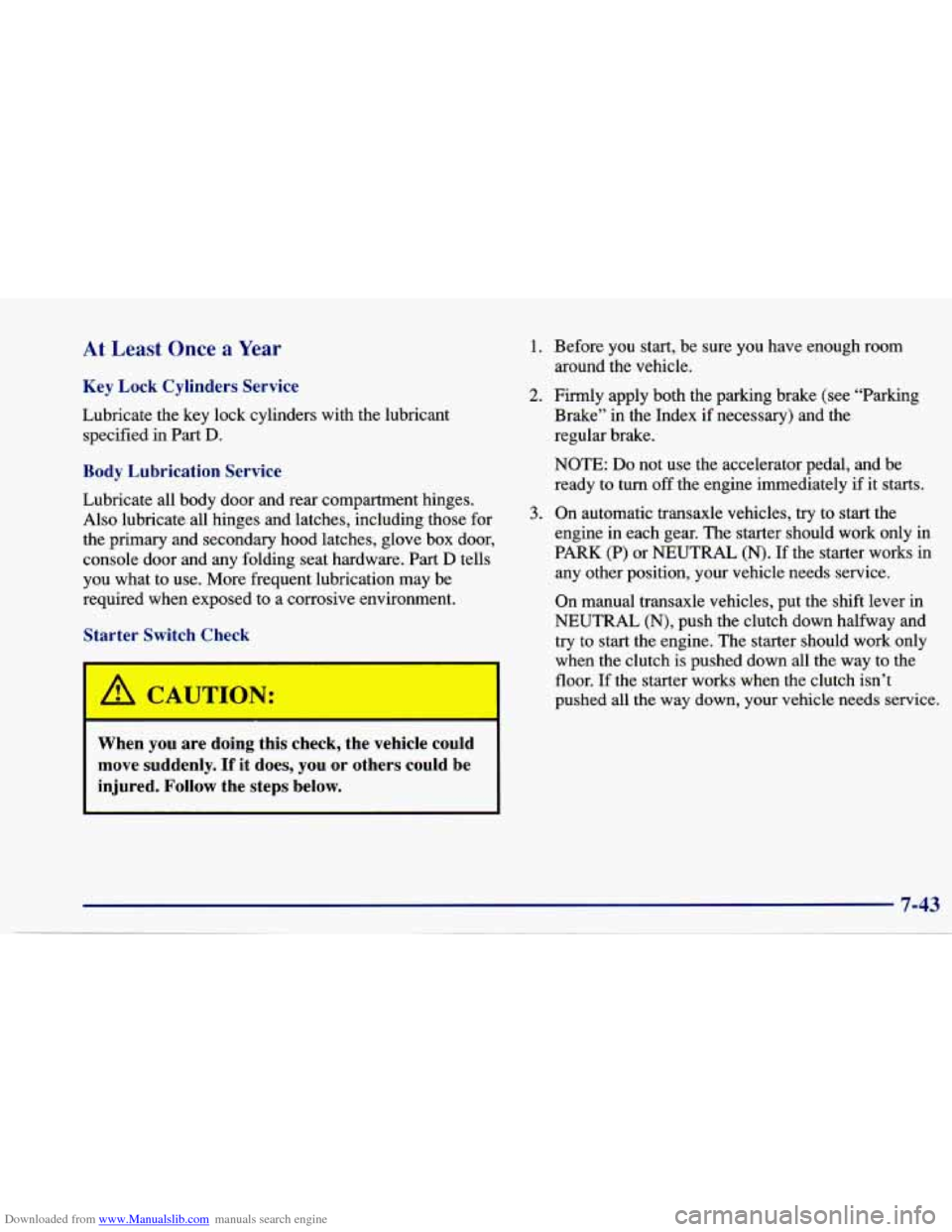
Downloaded from www.Manualslib.com manuals search engine At Least Once a Year
Key Lock Cylinders Service
Lubricate the key lock cylinders with the lubricant
specified in Part
D.
Body Lubrication Service
Lubricate all body door and rear compartment hinges.
Also lubricate all hinges and latches, including those for
the primary and secondary hood latches, glove box door,
console door and any folding seat hardware. Part
D tells
you what to use. More frequent lubrication may be
required when exposed to a corrosive environment.
Starter Switch Check
A CAUTION:
_. 7
When you are doing this check, the vehicle could
move suddenly.
If it does, you or others could be
injured. Follow the steps below.
1. Before you start, be sure you have enough room
around the vehicle.
2. Firmly apply both the parking brake (see “Parking
Brake” in the Index if necessary) and the
regular brake.
NOTE:
Do not use the accelerator pedal, and be
ready to turn off the engine immediately if it starts.
3. On automatic transaxle vehicles, try to start the
engine in each gear. The starter should work only in
PARK (P) or NEUTRAL (N).
If the starter works in
any other position, your vehicle needs service.
On manual transaxle vehicles, put the shift lever in
NEUTRAL (N), push the clutch down halfway and
try to start the engine. The starter should work only
when the clutch is pushed down all the way to the
floor.
If the starter works when the clutch isn’t
pushed all
the way down, your vehicle needs service.
Page 352 of 388

Downloaded from www.Manualslib.com manuals search engine Brake-Transaxle Shift Interlock (BTSI) Check (Automatic Transaxle)
When you are doing this check, the vehicle could
move suddenly. If it does, you or others could be
injured. Follow the steps below.
1. Before you start, be sure you have enough room around the vehicle. It should be parked on a
level surface.
2. Firmly apply the parking brake (see “Parking Brake” in the Index
if necessary).
NOTE: Be ready to apply the regular brake
immediately if the vehicle begins to move.
3. With the engine off, turn the key to the RUN
position, but don’t start the engine. Without applying
the regular brake, try to move the shift lever out of
PARK (P) with normal effort. If the shift lever
moves
out of PARK (P), your vehicle’s BTSI
needs service.
Ignition Transaxle Lock Check
While parked, and with the parking brake set, try to turn
the ignition key to LOCK in each shift lever position.
With an automatic transaxle, the key should turn to
LOCK only when the shift
lever is in PARK (P).
0 With a manual transaxle, the key should turn
to LOCK only when the shift lever is in
REVERSE (R).
On vehicles with a key release button, try to turn the key
to LOCK without pressing the button. The key should
turn to LOCK only when you press the key button.
On all vehicles, the key should come out only in LOCK.
Turn the steering wheel to the left and to the right. It
should only lock when turned to the right.
Page 353 of 388
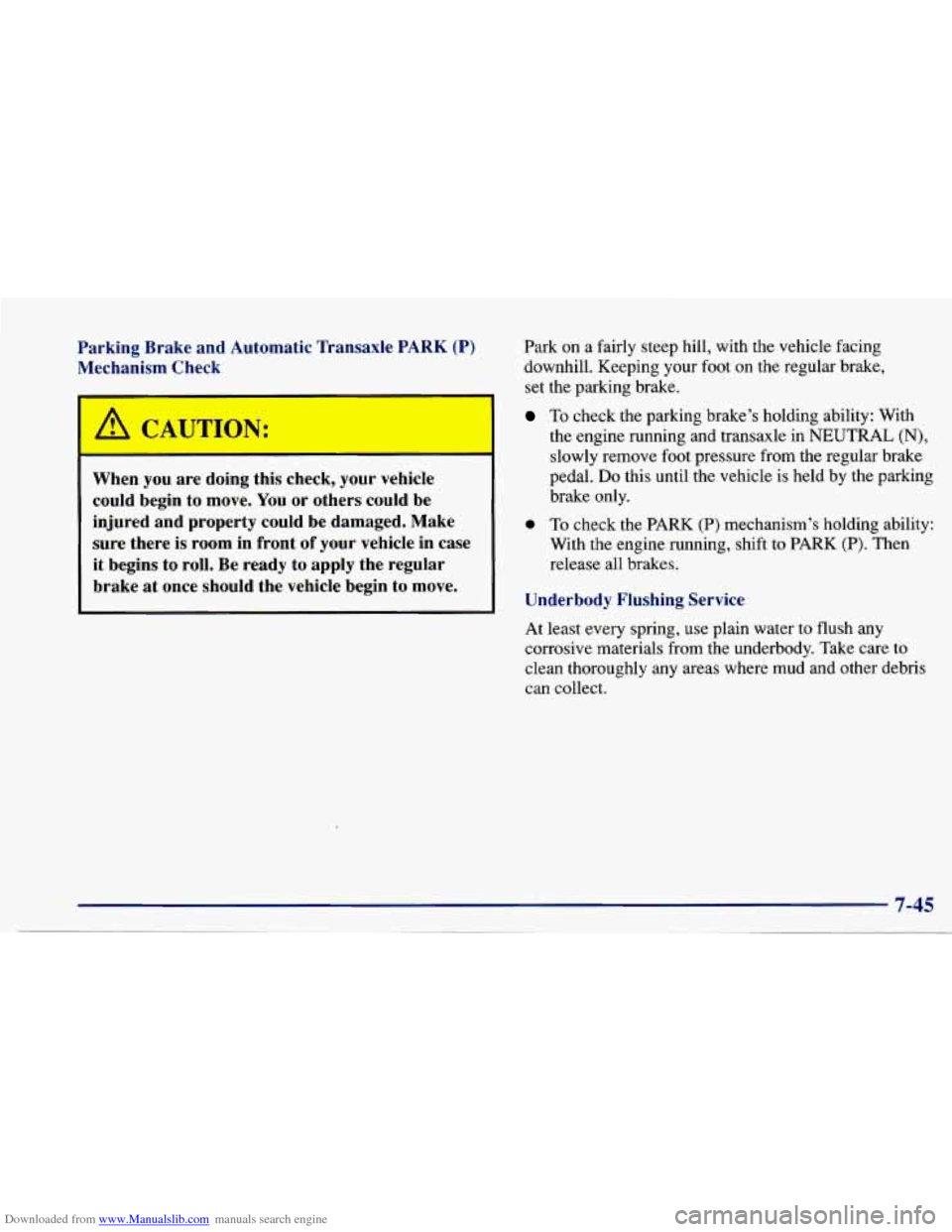
Downloaded from www.Manualslib.com manuals search engine Parking Brake and Automatic Transaxle PARK (P)
Mechanism Check
I A CAUTION:
When you are doing this check, your vehicle
could begin to move.
You or others could be
injured and property could be damaged. Make
sure there is room in front of your vehicle in case
it begins to roll. Be ready to apply the regular
brake at once should the vehicle begin to move. Park on a fairly steep
hill, with the vehicle facing
downhill. Keeping your
foot on the regular brake,
set the parking brake.
To check the parking brake’s holding ability: With
the engine running and transaxle in NEUTRAL (N),
slowly remove foot pressure from the regular brake
pedal.
Do this until the vehicle is held by the parking
brake only.
0 To check the PARK (P) mechanism’s holding ability:
With the engine running, shift
to PARK (P). Then
release all brakes.
Underbody Flushing Service At least every spring, use plain water to flush any
corrosive materials from the underbody. Take care to
clean thoroughly any areas where mud and other debris
can collect.
Page 355 of 388
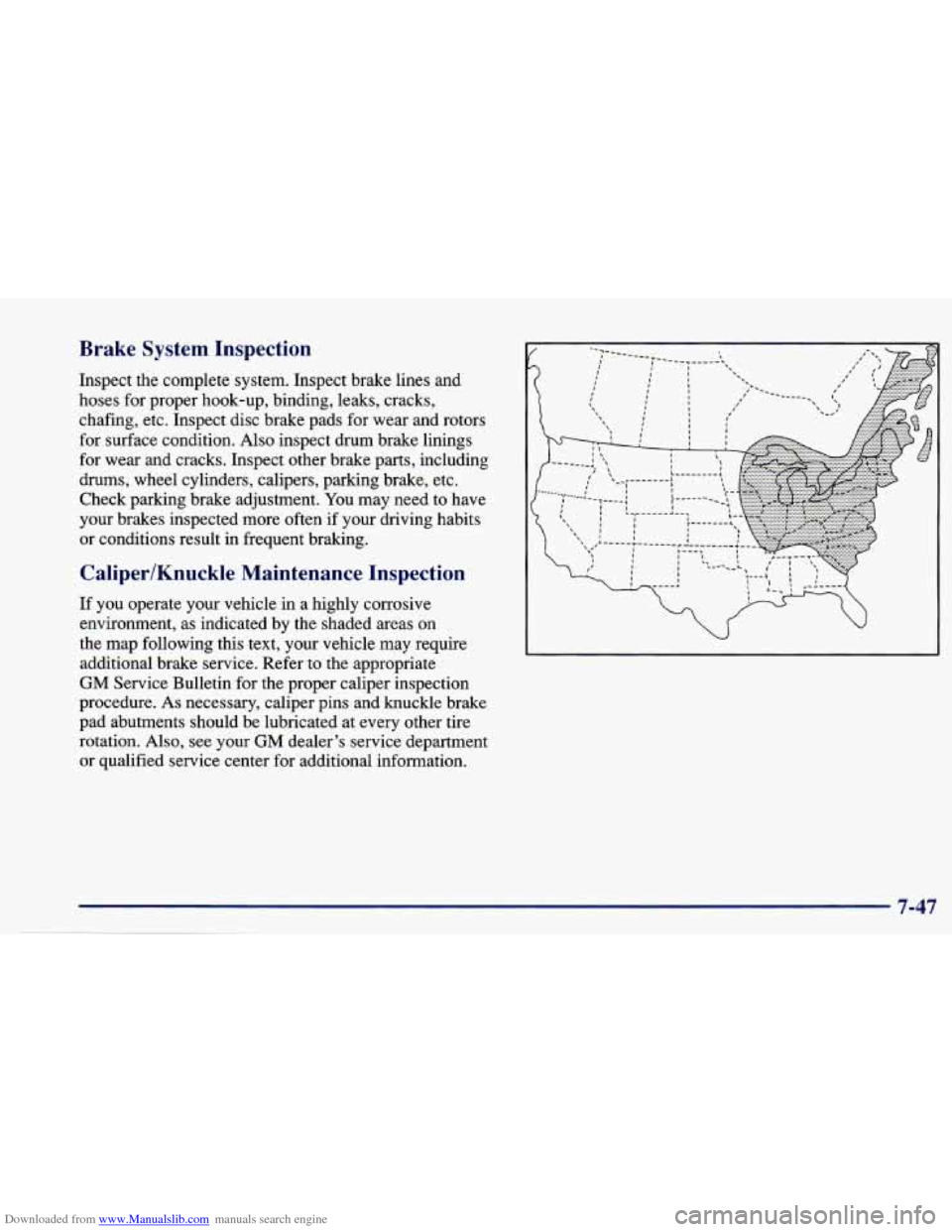
Downloaded from www.Manualslib.com manuals search engine ke System Inspection
Inspect the complete system. Inspect brake lines and
hoses for proper hook-up, binding, leaks, cracks,
chafing, etc. Inspect disc brake pads for wear and rotors
for surface condition. Also inspect drum brake linings
for wear and cracks. Inspect other brake parts, including
drums, wheel cylinders, calipers, parking brake, etc.
Check parking brake adjustment. You may need to have
your brakes inspected more often if your driving habits
or conditions result in frequent braking.
CalipedKnuckle Maintenance Inspection
If you operate your vehicle in a highly corrosive
environment, as indicated by the shaded areas
on
the map following this text, your vehicle may require
additional brake service. Refer to the appropriate
GM Service Bulletin for the proper caliper inspection
procedure. As necessary, caliper pins and knuckle brake
pad abutments should be lubricated at every other tire
rotation. Also, see your
GM dealer’s service department
or qualified service center for additional information.
7-47
Page 376 of 388
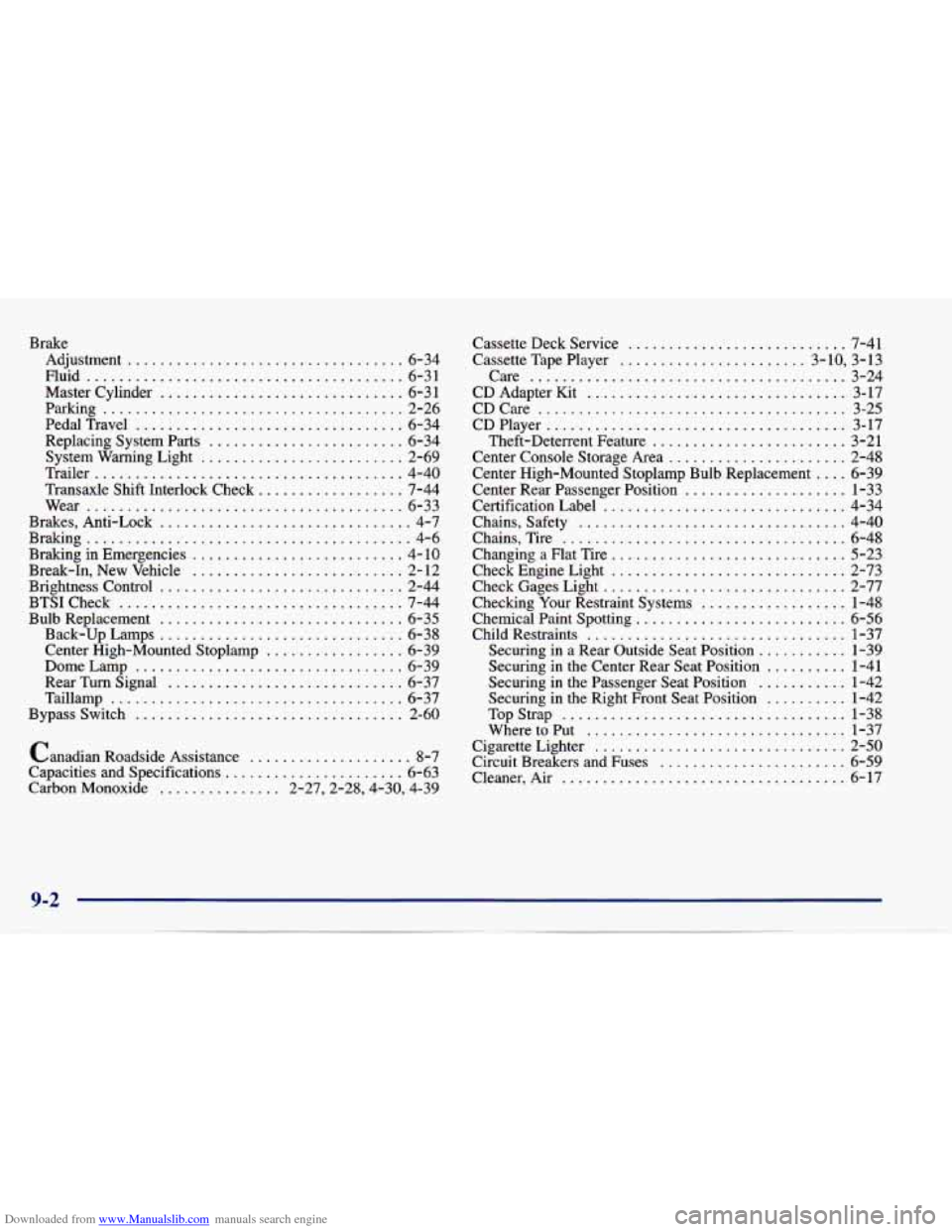
Downloaded from www.Manualslib.com manuals search engine Brake Adjustment
.................................. 6-34
Fluid
....................................... 6-31
Master Cylinder
.............................. 6-3 1
Parking
..................................... 2-26
PedalTravel
................................. 6-34
Replacing System
Parts ........................ 6-34
System Warning Light
......................... 2-69
Trailer
...................................... 4-40
Transaxle Shift Interlock Check
.................. 7-44
Wear
....................................... 6-33
Brakes, Anti-Lock
............................... 4-7
Braking
........................................ 4-6
Braking in Emergencies
.......................... 4- 10
Break-In, New Vehicle
.......................... 2-12
Brightness Control
.............................. 2-44
BTSICheck
................................... 7-44
Bulb Replacement
.............................. 6-35
Back-up Lamps
.............................. 6-38
Center High-Mounted Stoplamp
................. 6-39
Dome Lamp
................................. 6-39
RearTurnSignal
............................. 6-37
Taillamp
.................................... 6-37
Bypass Switch
................................. 2-60
Canadian Roadside Assistance
.................... 8-7
Capacities and Specifications
...................... 6-63
Carbon Monoxide
............... 2.27.2.28.4.30. 4.39 Cassette Deck Service
........................... 7-41
Cassette Tape Player
....................... 3- 10. 3.13
Care
....................................... 3-24
CD Adapter Kit
................................ 3-17
CDCare
...................................... 3-25
CD Player
..................................... 3-17
Theft-Deterrent Feature
........................ 3-21
Center Console Storage Area
...................... 2-48
Center High-Mounted Stoplamp Bulb Replacement
.... 6-39
Center Rear Passenger Position
.................... 1-33
Certification Label
.............................. 4-34
Chains. Safety
................................. 4-40
Chains. Tire
................................... 6-48
Changing a Flat Tire
............................. 5-23
Check Engine Light
............................. 2-73
Check Gages Light
.............................. 2-77
Checking Your Restraint Systems
.................. 1-48
Chemical Paint Spotting
.......................... 6-56
Child Restraints
................................ 1-37
Securing in a Rear Outside Seat Position
........... 1-39
Securing
in the Center Rear Seat Position .......... 1-41
Securing
in the Passenger Seat Position ........... 1-42
Securing in the Right Front Seat Position
.......... 1-42
TopStrap
................................... 1-38
WheretoPut
................................ 1-37
Circuit Breakers and Fuses
....................... 6-59
Cleaner. Air
................................... 6-17
Cigarette Lighter
............................... 2-50
Page 381 of 388
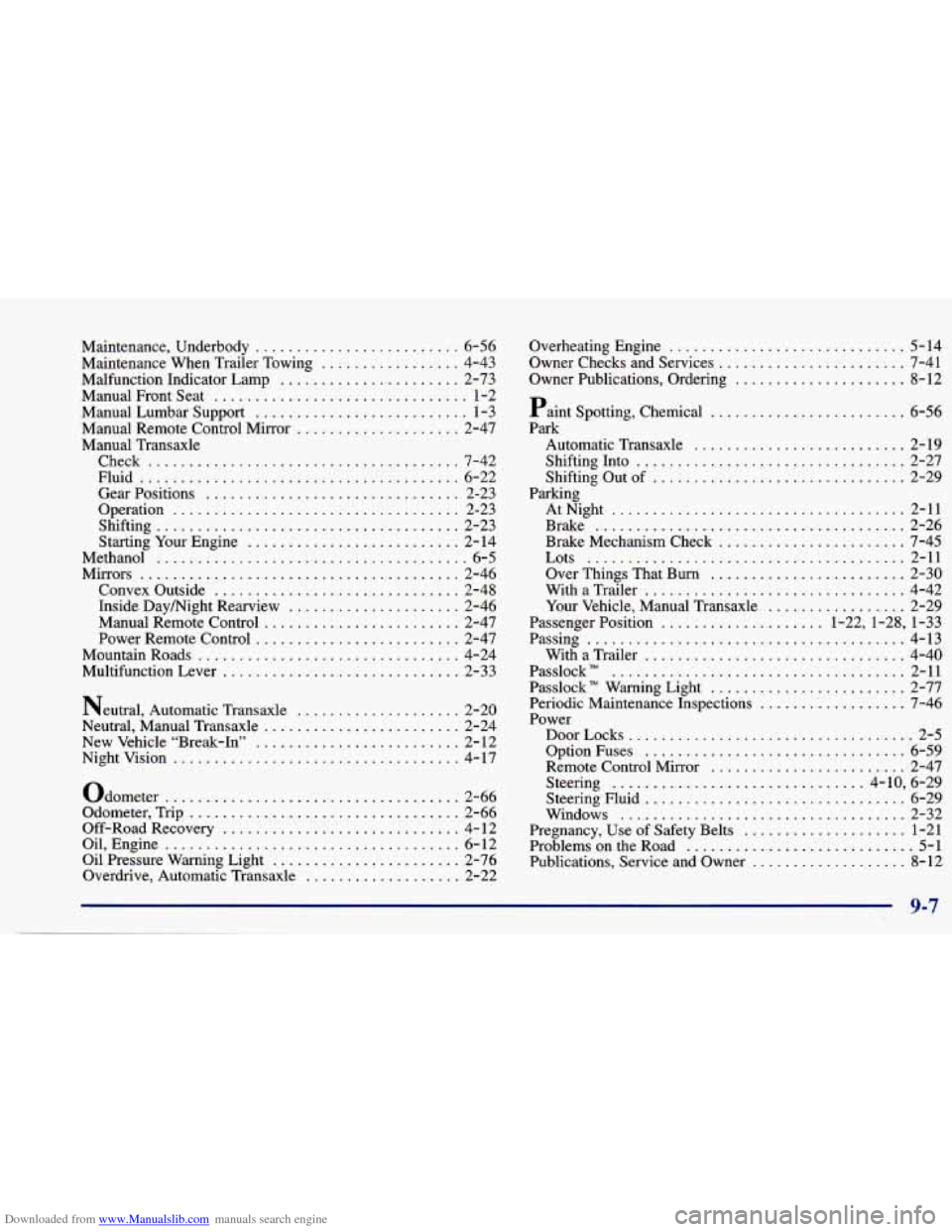
Downloaded from www.Manualslib.com manuals search engine Maintenance. Underbody ......................... 6-56
Maintenance When Trailer Towing
................. 4-43
Malfunction Indicator Lamp
...................... 2-73
Manual Front Seat
............................... 1-2
Manual Lumbar Support
.......................... 1-3
Manual Remote Control Mirror .................... 2-47
Manual Transaxle Check
...................................... 7-42
Fluid
....................................... 6-22
Gear Positions
............................... 2-23
Operation
................................... 2-23
Shifting
..................................... 2-23
Starting Your Engine
.......................... 2-14
Methanol
...................................... 6-5
Mirrors
....................................... 2-46
Convex Outside
.............................. 2-48
Inside Daymight Rearview
..................... 2-46
Manual Remote Control
........................ 2-47
Power Remote Control
......................... 2-47
MountainRoads
................................ 4-24
Multifunction Lever
............................. 2-33
Neutral. Automatic Transaxle
.................... 2-20
Neutral. Manual Transaxle
........................ 2-24
New Vehicle “Break-In”
......................... 2-12
Nightvision
................................... 4-17
Odometer
.................................... 2-66
Odometer. Trip
................................. 2-66
Off-Road Recovery
............................. 4- 12
Oil. Engine
.................................... 6-12
Oil Pressure Warning Light
....................... 2-76
Overdrive. Automatic Transaxle
................... 2-22 Overheating Engine
............................. 5-14
Owner Checks and Services
....................... 7-41
Owner Publications. Ordering
..................... 8-12
Paint Spotting. Chemical
........................ 6-56
Park
Automatic -:ansaxle
.......................... 2-19
Shifting Into
................................. 2-27
Shifting Out of
............................... 2-29
Parking AtNight
.................................... 2-11
Brake
...................................... 2-26
Brake Mechanism Check
....................... 7-45
Lots
....................................... 2-11
Over Things That Burn
........................ 2-30
With a Trailer
................................ 4-42
Your Vehicle. Manual Transaxle
................. 2-29
Passenger Position
.................... 1-22. 1-28. 1-33
Passing
....................................... 4-13
With a Trailer ................................ 4-40
Passlock
” .................................... 2-11
Periodic Maintenance Inspections
.................. 7-46
Power
DoorLocks
................................... 2-5
Option Fuses
................................ 6-59
Remote Control Mirror
........................ 2-47
Steering
............................... 4.10. 6.29
Windows
................................... 2-32
Pregnancy. Use of Safety Belts
.................... 1-21
Problems on the Road
............................ 5-1
Publications. Service and Owner
................... 8-12
Passlock”
Warning Light
........................ 2-77
Steering Fluid
................................ 6-29
9-7